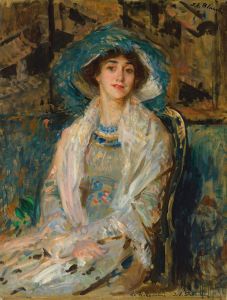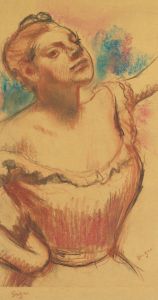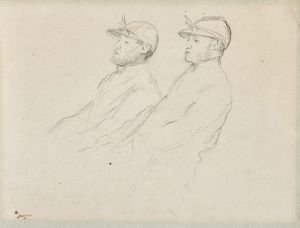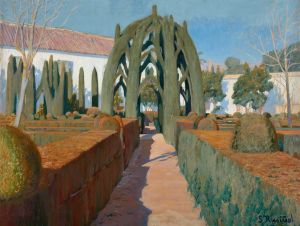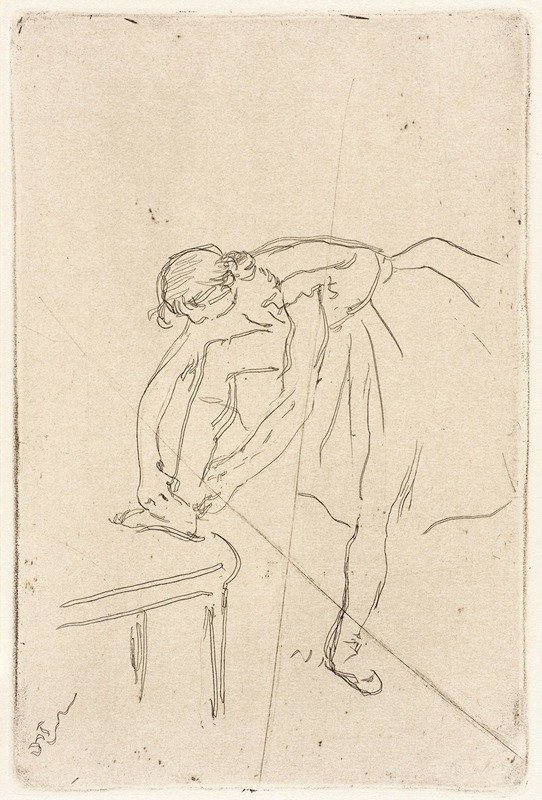
Danseuse mettant son chausson
A hand-painted replica of Edgar Degas’s masterpiece Danseuse mettant son chausson, meticulously crafted by professional artists to capture the true essence of the original. Each piece is created with museum-quality canvas and rare mineral pigments, carefully painted by experienced artists with delicate brushstrokes and rich, layered colors to perfectly recreate the texture of the original artwork. Unlike machine-printed reproductions, this hand-painted version brings the painting to life, infused with the artist’s emotions and skill in every stroke. Whether for personal collection or home decoration, it instantly elevates the artistic atmosphere of any space.
Edgar Degas's Danseuse mettant son chausson (translated as Dancer Adjusting Her Slipper) is a notable work by the French Impressionist artist, who is renowned for his depictions of ballet dancers. This artwork is part of Degas's extensive exploration of the world of dance, a subject that dominated much of his artistic career. Created in the late 19th century, the painting exemplifies Degas's fascination with capturing the intimate, behind-the-scenes moments of dancers, rather than their performances on stage.
The composition portrays a ballerina seated on the floor, adjusting her slipper. Degas's focus on this seemingly mundane action reflects his interest in the everyday routines and physical demands of dancers. The figure is rendered with a sense of immediacy and naturalism, emphasizing the physicality and grace of the dancer's form. Degas's use of light and shadow, combined with his mastery of line and movement, brings a sense of vitality to the scene.
Degas often worked in a variety of media, and Danseuse mettant son chausson is no exception. While many of his works on dancers were executed in oil paint, pastels, or mixed media, this particular piece is widely recognized as a pastel drawing. Pastels allowed Degas to achieve a softness and vibrancy in his depiction of textures, such as the delicate fabric of the dancer's costume and the subtle tones of her skin. This medium also enabled him to experiment with color and layering, which became hallmarks of his style.
The painting is characteristic of Degas's approach to composition, which often involved cropping figures in unconventional ways, influenced by the burgeoning art of photography and Japanese prints. In Danseuse mettant son chausson, the dancer is placed slightly off-center, and the surrounding space is minimally detailed, drawing the viewer's attention to the figure's pose and gesture. This compositional choice enhances the sense of intimacy and immediacy in the scene.
Degas's works on dancers, including Danseuse mettant son chausson, are celebrated for their ability to convey both the elegance and the laborious effort of ballet. Rather than idealizing his subjects, Degas presented them as real individuals engaged in rigorous practice and preparation. His focus on these candid moments offers a glimpse into the discipline and dedication required of dancers, while also showcasing his technical skill and innovative approach to art.
Today, Danseuse mettant son chausson is held in a private collection, and its exact date of creation is not definitively documented. However, it is generally attributed to the late 19th century, during the height of Degas's engagement with the theme of dance. The work continues to be admired for its artistic merit and its contribution to the broader understanding of Degas's oeuvre.







